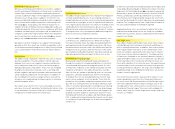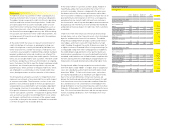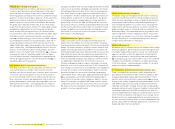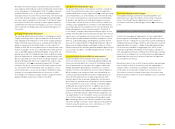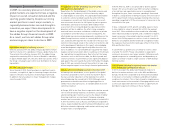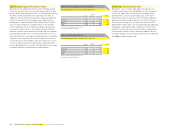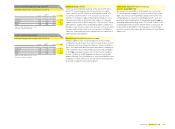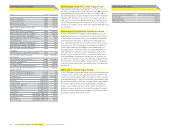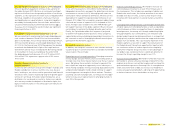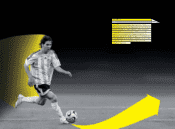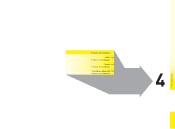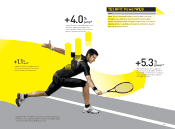Reebok 2008 Annual Report Download - page 124
Download and view the complete annual report
Please find page 124 of the 2008 Reebok annual report below. You can navigate through the pages in the report by either clicking on the pages listed below, or by using the keyword search tool below to find specific information within the annual report.
120 Group Management Report – Our Financial Year Subsequent Events and Outlook
Subsequent Events and Outlook
In 2009, recessionary pressures in most key
global markets are expected to have a negative
impact on overall consumer demand and the
sporting goods industry. Despite our strong
market positions in most major markets, a
regionally balanced sales mix and strength in
innovation, we expect these developments to
have a negative impact on the development of
the adidas Group’s fi nancial results in 2009.
As a result, we forecast adidas Group sales
and earnings per share to decline in 2009.
Subsequent changes in the Group structure
Effective January 2009, the adidas Group acquired the remain-
ing 5% of shares of its subsidiary in Greece, adidas Hellas A.E.,
Thessaloniki. Also effective January 2009, the adidas Group
acquired the remaining 25% of shares of Reebok’s subsidiary
in Spain, Reebok Spain S.A., Alicante. Both transactions refl ect
the Group’s strategy to gain control over distribution in matur-
ing markets.
No other subsequent changes
Since the end of 2008, there have been no signifi cant macro-
economic, sociopolitical, legal or fi nancing changes which we
expect to infl uence our business materially going forward.
In addition, there have been no major management changes
since the end of 2008.
Group business outlook affected by uncertain global
macroeconomic development
Expectations for the development of the global economy and
the sporting goods industry in 2009 are currently subject
to a high degree of uncertainty. The unprecedented slowdown
in economic activity recorded towards the end of 2008 has
consequences currently not fully foreseeable. As a result,
macroeconomic forecasts for 2009 given by various govern-
ment bodies and research institutes differ widely in their
assessment of how long and deep the expected economic
downturn will be. In addition, the effect rising unemploy-
ment and lower consumer confi dence could have on private
consumption cannot be fully assessed. Consequently, the
effect global macroeconomic developments could have on the
adidas Group’s business outlook is currently diffi cult to fore-
cast, especially with regard to the second half of the year. Our
outlook is hence based solely on the scenario of economic and
sector development laid down in this report, acknowledging
actual developments might signifi cantly differ from this sce-
nario. In addition, it is currently diffi cult to quantify the impact
negative currency translation effects could have on the Group’s
top- and bottom-line performance. Due to the fact that many
currencies such as the Russian ruble, the British pound and
several currencies in Latin America have signifi cantly depreci-
ated against the euro towards the end of 2008 and at the begin-
ning of 2009, we currently forecast these effects to have a sig-
nifi cant negative impact on our Group’s fi nancial performance.
Global economic slowdown projected to intensify in 2009
According to the World Bank, in 2009 growth of the global
economy is projected to slow to a level of around 1% due to
the real-economy side effects of the banking crisis which
inten sifi ed during the second half of 2008. Although several
governments around the world are instigating policies to
combat recessionary pressures, an outright global recession
cannot be ruled out.
In Europe, GDP in the Euro Zone is expected to decline around
1.5% in 2009, driven by weakness in domestic consumption,
a deteriorating export outlook as well as the impact of tighter
fi nancing conditions on investment. European emerging
markets are forecasted to show modest growth of around 0.5%
in 2009. Economies such as Russia and Turkey are expected to
show a steep slowdown based on falling commodity prices and
diffi culties related to tightening credit markets which may lead
to higher levels of unemployment.
In North America, GDP is also projected to decline approxi-
mately 1.5% versus the prior year. With consumer confi dence
at record lows and expected increases in unemployment
throughout the year, lower consumer spending is forecasted
to lead to a sharp decline in GDP particularly in the fi rst half of
2009. A government stimulus package involving infrastructure
spending is expected to lift the economy out of recession in the
second half of the year.
In Asia, compared to 2008, growth excluding Japan is likely
to slow slightly to a level of around 5% in 2009, the weakest
since 2001. China and India are forecasted to be affected by
lower industrial production growth, and a slowdown of exports.
Japan’s economy is forecasted to decline around 3% in 2009
versus 2008. Falling exports as well as a lack of stimulus for
domestic consumption and the likelihood of stagfl ation make
the Japanese macroeconomic landscape similar to that in the
USA and the Euro Zone.
In Latin America, growth rates are likely to slow to a level
of around 1% in 2009. Private consumption is expected to
continue to increase in most major markets. Differences with
regard to exposure to commodity prices and dependency on
exports are likely to lead to a high variance of GDP develop-
ment by country.
Low consumer spending to negatively impact the develop-
ment of the global sporting goods industry
In 2009, we expect the global sporting goods industry to
decline. In mature markets such as the USA and Western
Europe, the decline is expected to be more pronounced due
to low levels of consumer confi dence and diffi cult trading
conditions for retailers. This is likely to lead to a highly promo-
tional environment in these markets. Emerging markets such
as China are expected to be more resilient as opportunity for
distribution expansion continues in these markets.



